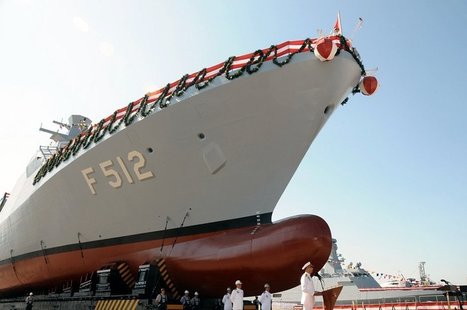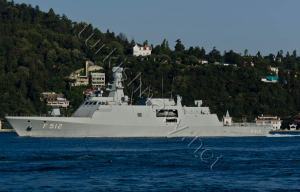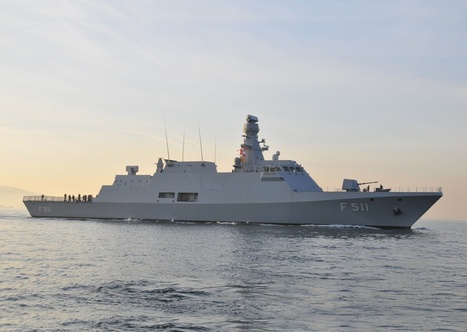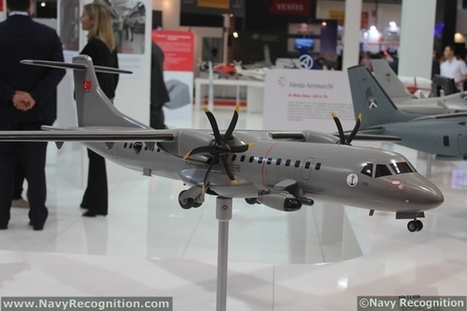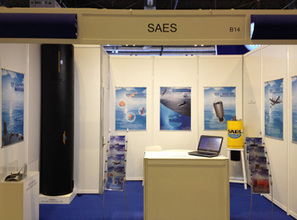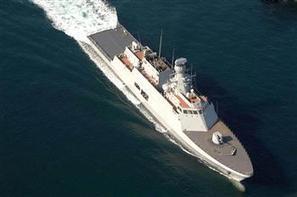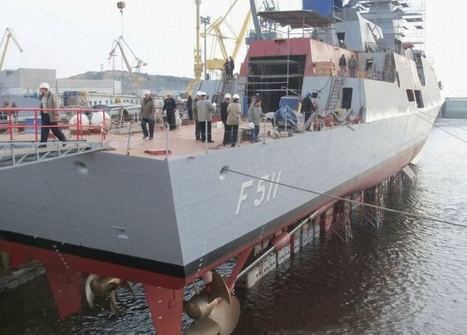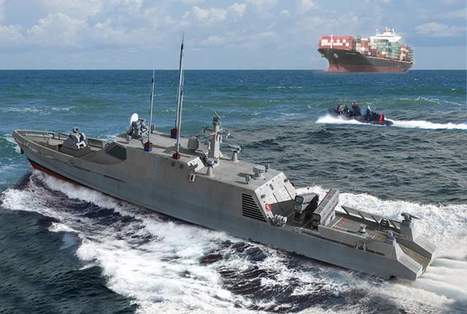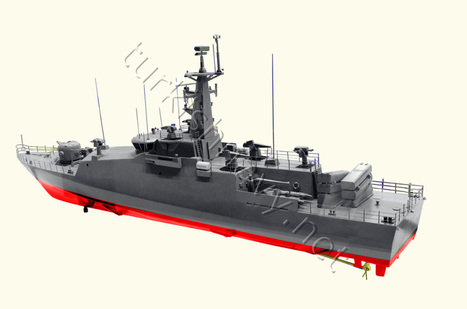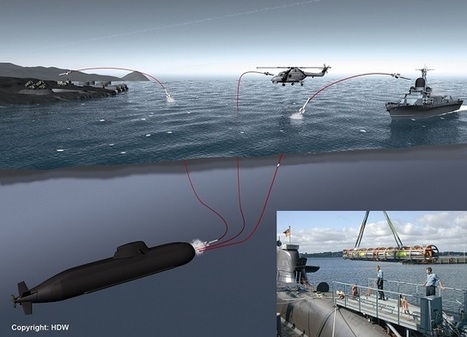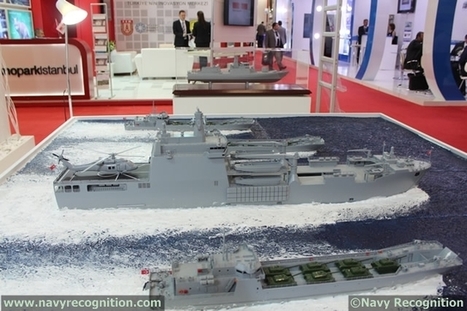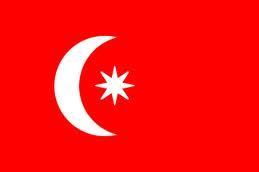 Your new post is loading...

|
Scooped by
Patrick H.
September 29, 2013 11:13 AM
|
The Turkish government decides to continue the program MILGEM corvettes in the arsenals of the Navy and call a new tender after the cancellation of the 6 ships awarded to RMK Marine. 26/09/2013.- The extraordinary meeting today the Executive Committee for the Defense Industry (SSIK), chaired by Prime Minister Recep Tayyip Erdoğan, was closed after more than three hours without LPD program decisions, providing building an amphibious assault ship for the Turkish Navy and three holdings aspiring local industry through the shipyard RMK Marine, Desan and Sedef. The thrust of this program is again postponed naval. The Turkish government preferred to focus its efforts on closing the open front after the failed bid 6 corvettes MILGEM program that sought to deliver to private industry. Corvette MILGEM The contract was awarded earlier this year to the shipyard RMK Marine, ultimately annulled decision "in the interests of the public good" following a report in the wake of the protests filed by Dearsan, finalist in the bidding. At the meeting on Thursday, the decision was urged by the Turkish Navy, to continue the construction of the third and fourth unit of the series of corvettes MILGEM (acronym for "national ship" in Turkish), in the Navy Arsenal Istanbul. The first two units, Heybeliada and Buyukada F-511 F-512 had already been lined in Navy industrial facilities. This is to save entail delays restart the hiring process vessels. The other 4 corvettes will ultimately be the subject of a new tender to be invited to private shipyards. The ministry sought with these calls introduce the ability to build military vessels of different types and complexity between the Turkish naval industries, traditionally linked to the construction of units destined for the civilian market. Delivery of the second sloop and keel laying of the third Just this Friday is the day of the Turkish Navy, on the anniversary of the Battle of Previsa (Preveza today) faced in 1538 the Christian fleet commanded by Andrea Doria, at the service of the Emperor Charles, and the Ottoman admiral Jeireddín "Barbarossa". Taking advantage of the symbolism of the date, will be held in the premises of the arsenal of Pendik, Istanbul, multiple ceremony of commissioning of the second corvette MILGEM, Buyukada F-512, and the keel laying of the third, Burgazada F- 513. The MILGEM-or class corvettes Ada-are vessels 99.5 meters long by 14.4 meters wide, displacing 2,300 tons at full load. Its engine package comprises two diesel engines and gas turbine 1 in combination CODAG.

|
Scooped by
Patrick H.
September 25, 2013 3:06 PM
|
The Milgem project will make an important step on 27 September 2013. The 27th September, the anniversary of the Battle of Preveza, celebrated as the Turkish Naval Forces Day. This year the second Milgem class corvette F-512 TCG Büyükada will enter into service and the keel of the third ship F-513 TCG Burgazada will be laid at the Istanbul Naval Shipyard. This is the big step. As reported earlier the tender for the construction of the 6 additional Milgem class corvettes at the RMK Shipyard was cancelled and the future of the programme was in uncertainty. The plan was, that the third ship was going to be constructed at the naval shipyard in Istanbul where the personnel of the private shipyard would receive a hands on training on the how to build a naval warship like a naval shipyard. Turkish Navy cannot afford, not to have more Milgem class corvettes thus they must have stepped in and decided to go ahead with the construction of the third ship themselves.

|
Scooped by
Patrick H.
August 30, 2013 12:25 PM
|
On August 29th 2013, the last ship of the LCT (Landing Craft Tank) Project TCG Ç-158 constructed by Turkish Anadolu Shipyard(ADIK) left ADİK bay. ”Having realized the final delivery of TCG Ç-158 on August 28th 2013 after 12 months of warranty period, considering the shipyard’s first experience on a Navy project, we are feeling very proud of achieving “on time” deliveries of the entire project as scheduled in its calendar,” Cevat R. Atilhan, ADIK’s Production Manager of Navy Projects said in a release. ”In this respect, I take the opportunity to express my gratitude to everyone involved in the Project, but especially to all my team members who have worked day and night, thus establishing a trustworthy relation with the SSM Office, Turkish Navy Forces committees and the ships’ staff,” he further added.

|
Scooped by
Patrick H.
August 14, 2013 3:52 AM
|
ANKARA — Turkey’s procurement authorities, under orders from Prime Minister Recep Tayyip Erdogan, may revise a contract for the production of six corvettes, officials said. “Under new deliberations we may rethink this contract and revise negotiations,” an official said, without elaborating on the reasons. The Turkish government in January signed the contract, dubbed “national ship” or Milgem in its Turkish acronym, with the Istanbul-based shipyard RMK Marine, owned by Turkey’s biggest industrial conglomerate, Koc Holding. Defense News reported July 8 that Koc Holding’s defense business could be a casualty of a row between the country’s prime minister and one of its top executives after a month of civil unrest that has battered the Turkish government. The report quoted an analyst as saying, “It should come as no surprise if the government decided to thoroughly scrutinize all Koc-related contracts, including defense deals.” The story also said that some of these RMK and Otokar contracts may face revisions and some future deals could change. In one incident during month-long demonstrations in June, protesters tried to escape police tear gas and pepper spray by taking refuge in a posh Istanbul hotel, Divan, owned by Koc. Hotel management admitted the protesters to its lobby, which quickly turned into a makeshift first aid room. The police fired more tear gas and pepper spray into the hotel lobby although it is illegal to fire these chemicals into indoor spaces. It was reported that Ali Koc, a board member and third generation family members had ordered the hotel to help the protesters. On June 16, an angry Erdogan said in a public rally: “We know which hotel owners helped terrorists [protesters]. It is a crime to abet terrorists. And those crimes will not remain unpunished.” The Milgem contract is worth $2.5 billion. The corvettes are the smallest warships in the Turkish Navy’s inventory. Turkey plans to use the experience gained in the Milgem project to design, develop and construct its first national frigate, the TF-2000, in the 2020s. Earlier, RMK Marine had won a contract to build four search-and-rescue ships for the Turkish Coast Guard.

|
Scooped by
Patrick H.
August 6, 2013 6:22 AM
|
05/08/2013 (Infodefensa.com) Madrid - Navantia shown in Turkey its ability to design and build modern frigates as the F-100 . One unit of this class, the F-103 Blas de Lezo , arrived on July 25 to Istanbul , where he was visited by representatives of the Directorate General of Armament and Equipment of Turkey and the Navy of the country. The F103 , which is acting as the command ship of the Naval Band Standing NATO No. 2 ( SNMG-2 ), a role she will continue to play until October. During his stopover Turkish makers explain Navantia , the boat caught the attention of representatives of the Directorate General of Armament and Material ( DGMA ) from Turkey, and the Turkish Navy, who conducted a technical visit to the ship on July 26 . The Spanish Admiral currently leading the SNMG-2, Eugenio Diaz del Rio , was responsible for receiving this Turkish delegation, headed by the chief platforms of DGAM, Mustafa Seker . The technical visit was also attended by addition of Defence , the Colonel Julian Paul , the Commercial Director of Navantia , Gonzalo Mateo-Guerrero , the delegate of the Office of Navantia in Turkey , Jorge García-Wallet , and American business professionals Lockheed Martin , developer of the combat system Aegis riding the F-100 . The five frigates of this class commissioned by the Spanish Armada to the system Navantia have Aegis and are prepared to lead a multinational naval force as SNMG-2. This group, formed by vessels of several members of NATO , participating in operations Ocean Shield , to combat piracy in the Indian , and Active Endeavour , the fight against terrorism in the Mediterranean . Navantia has had the collaboration of the Spanish Armada and the strength of the F-103 to show the characteristics of the F-100 to the Turkish authorities for their ship in the country. Navantia has already sold to Australia design and construction technology in that country of three destroyers based on the Spanish frigate F-100 . The first of its kind with the Aegis combat system The F-100 has a length of 146.7 meters, a maximum width of 18.6 meters and a maximum load of 5,900 tons. They are designed to develop anti-aircraft operations ( AWW ), operate as the flagship of a battle group in conflict zones, protect and support fleet operations using his escort-surface warfare capability ( ASuW ) and submarine ( ASW ), and conduct fire support to ground. Each ship is capable of reaching a speed of 28 knots, has a range at cruising speed (18 knots) of 4,500 nautical miles and can run for a whole month without replenishing supplies. These are the first frigates capable of incorporating the combat system Aegis radar and Spy-1D .

|
Scooped by
Patrick H.
July 5, 2013 7:25 AM
|
Photo : P-338 TCG Bora will take part in the Bulgarian naval exercise Breeze-2013 in the Black Sea. Bulgarian Naval Forces are hosting an international naval exercise called Breeze 2013 between 6 and 15 July 2013. According to Turkish Navy Turkish Gür class (Type 209/1400 Mod) submarine S-360 TCG Birinci İnönü is taking part in the exercise as well as the fast attack craft TCG Bora and the minesweeper TCG Sığacık. NATO’s SNMCMG-2 will take part in this exercise along with Bulgarian units. As Bulgaria decommissioned its last submarine in 2011 Turkey is the only NATO nation in the Black Sea that can provide submarines for the naval exercises.

|
Scooped by
Patrick H.
May 25, 2013 1:15 PM
|
ANKARA — Turkey has engaged with a major U.S. ballistic missile defense
project. Turkey’s state-owned Havelsan has been participating in the U.S. Aegis
program, designed to intercept ballistic missiles from the sea. Havelsan has
contributed naval combat management capabilities to enhance Aegis, led by Lockheed Martin. Aegis has been procured by the navies of Australia, Japan, Norway, Spain
and the United States. L-M did not say how the Havelsan management system differed from other Aegis models. “We’ve now witnessed in real time how well our systems work together,
which also speaks to the strong and significant partnership of our two
companies within the industry,” Carl Bannar, a vice president at Lockheed
Martin’s Mission Systems and Training business, said. The partnership was demonstrated during a naval combat system mockup at IDEF-2013 in Istanbul in May. Executives said Havelsan and L-M — which in 2011 signed an agreement to cooperate on naval combat systems — developed interfaces to combine their technologies in what was meant to be marketed to Middle East states, particularly the Gulf Cooperation Council. “We have demonstrated that we can enhance our existing naval combat
management system capabilities by using data from the naval radar, Spy-1,”
Havelsan chief executive officer Sadik Yamac said. Yamac said Havelsan, a contractor for the Turkish Navy, leveraged the
capabilities of Aegis to produce what he termed a “total naval combat system
for the most stressing operational requirements of many countries.” The
executive did not report any Turkish Navy interest in Aegis, which was
preparing to receive a new interceptor variant, SM-3 Block 1B. “The combined technology of Turkish-Aegis combat system can be a
considerable solution for the countries in Middle East region and some other
countries,” L-M said on May 9.

|
Scooped by
Patrick H.
May 16, 2013 3:50 AM
|
Turkey's Ministry of Defence Undersecretariat for Defence Industries (SSM) is planning to kickstart its next-generation TF-2000 anti-air warfare frigate program in the coming months, with plans under way to launch the design phase of the project by the end of the year. The TF-2000 project aims to provide the Turkish Naval Forces with up to six frigates at an estimated cost of between $.6 billion and $3 billion, with entry into service planned from around the end of the decade. The locally built frigate design, expected to displace more than 6,000 tonnes, will have a strong anti-air warfare bias centred on a multifunction radar and a medium-range area air-defence missile system. The SSM was unable to progress the program to the next stage until the Turkish Naval Forces completed an assessment of which version of Raytheon's Standard Missile would be most suitable for the new frigate. This assessment has now been concluded, with the navy opting to continue with the SM-2. Due to the large scope of the program, a decision has been made to split it into three phases, beginning with a design phase, followed by construction of a prototype ship, and then finally serial production.

|
Scooped by
Patrick H.
May 13, 2013 12:48 PM
|
13/05/2013 (Infodefensa.com) Madrid - The Spanish company Navantia expects the Turkish government awarded within a month the competition held for the construction of a multipurpose ship LHD-type to which the company concurs in partnership with a Turkish shipyard. The forecast was that the resolution of the contest was given earlier this year, in the first meeting of the authority of the country, but at that time there was no decision, so Spanish shipyards are confident that the final decision reached at the second meeting in early June. Turkey will build the ship in a local shipyard Navantia, as well as other foreign companies involved in the process, act as a technology partner. Specifically, the Spanish company participates in partnership with the industrial group Sedef , one of the strongest in Turkey. In addition, the company has extensive experience in the construction of these ships and the bidder country and knows the capabilities and versatility of Juan Carlos I , who in his resistance cruise traveled to Istanbul and could be visited by the Turkish authorities . To continue promoting the vessel in the area, Navantia sales team, with Gonzalo Mateo Guerrero, Director of Business, in front, moved last week to the security and defense exhibition IDEF was developed in Istanbul, where he presented the capacity of the frigate F-100 and its next evolution, the F-110 , facing the program for the construction of four frigates Turkish Navy is planning to launch in the coming years Navantia is also configured for this program as a preferred option due to its association with the American Lockheed Martin and combat system Aegis , which has already been pointed out by the Turkish government as to their future chosen escort vessels.

|
Scooped by
Patrick H.
May 11, 2013 3:37 PM
|
Alenia Aermacchi has signed an agreement with Savunma Sanayii Müstesarligi (SSM), the Turkish Undersecretariat for Defence Industries to deliver two ATR 72-600 TMUA (Turkish Maritime Utility Aircraft) and six ATR 72-600 TMPA (Turkish Maritime Patrol Aircraft) to the Turkish Navy.
The contract calls for strong industrial collaboration between Alenia Aermacchi and Turkish Aerospace Industry (TAI) for the duration of the project. The agreement is an amendment to a previous deal between Alenia and the Turkish government for the delivery of 10 ATR 72-500 ASW to the Turkish Navy.
The most important change into the contract amendment is the adoption of the new -600 version of the ATR 72, the best in class of regional Turboprop. The original contract was based on the now out of production ATR 72-500.
Thanks to the agreement, the Turkish Navy will obtain the last generation ATR72-600 equipped with a glass cockpit as well as more powerful engines that guarantee best performance and supportability for the next 30 years.
The two ATR 72-600T MUA -- already in the modification phase at Alenia Aermacchi’s plant in Naples-Capodichino -- will be used by the Turkish Navy for personnel and cargo transport and will be delivered in June and July 2013.
The six ATR 72-600T MPA are designed as multi-role assets to satisfy the Turkish Navy maritime patrol requirement. The aircraft, named Meltem 3 in Turkey, will see the integration of the Thales AMASCOS mission system and will include new functionalities such as AIS, Link 16 and the last generation weapon systems, like the Mk 54 Light Weight Torpedo.
The AMASCOS (Airborne Maritime Situation & Control System) mission system relies on multiple sensors to detect, identify and track threats, maintain real-time tactical situation awareness, manage NATO and national tactical data links and deploy onboard weapon systems.
While Alenia Aermacchi is responsible for the design and development of the transformation of the basic platform and for the mission system’s installation and integration with the on-board systems of the basic aircraft, Thales will act as lead systems integrator for the ATR 72-600’s new avionics suite which offers improved performance in terms of reduced weight and electrical power consumption as well as higher reliability and better long-term serviceability.
The work to convert the “green” ATR 72-600 in ATR 72-600TMPA will be performed by TAI, Turkish Aerospace Industry. The first ATR 72-600 arrived at TAI’s Akinci plant in April 2013 and is currently under modification.
The first TMPA will be delivered to the Turkish Navy in February 2017. The aircraft will be certified in Italy under the responsibility of Alenia Aermacchi. The remaining five TMPA will be delivered in 2018.

|
Scooped by
Patrick H.
May 3, 2013 9:28 AM
|
The renowned Pakistani Naval expert and journalist Usman Ansari mentioned in his article in the May issue of the Warships International, about the Aman 2013 exercise, that Pakistani Navy has acquired the GENESIS combat management system for its Perry class frigate F-260 PNS Alamgir. This is the first official acknowledgement that Turkey has sold the GENESIS CMS to Pakistani Navy, thought this has been rumored in Turkish for a couple of years. This is the first export success of the GENESIS CMS. GENESIS was conceived by the Research, Project Development, Department of Turkish Navy. They built a prototype as a proof of concept and developed the system to the full extend. After the system got enough maturity the GENESIS project was handed over to Turkish defence contractor Havelsan for further improvement, serial production and international marketing. The GENESIS was created to update the old CIC of the Perry class frigates and replace all legacy consoles, displays with modern multifunction operator consoles. More importantly with the implementation of GENESIS all existing sensors and weapon systems of the Perry class frigates will be able to communicate with each other. This system enhances the ships’ situation awareness and accelerates the defense capabilities, decreasing the detect-to-engage reaction time by more than half. F-492 TCG Gemlik was the first ship to receive the GENESIS system. As is GENESIS is marketable to almost all second-hand PERRY class frigate users. Thus Pakistani Navy becomes the first foreign user of the GENESIS CMS. Of course important questions like when the deal was signed what is the value of the contract what is the delivery time line are remain unanswered yet.

|
Scooped by
Patrick H.
March 20, 2013 3:49 AM
|
20/03/2013 (Infodefensa.com) Madrid - SAES , a company specializing in underwater acoustics and electronics, has advised delegations from Malaysia and Turkey on security in the marine environment. It was during the IV International Exhibition of Defence and Security Technologies Homsec 2013 , held in Madrid from 12 to 15 March. The company has received numerous visits from national and international delegations, which have been especially concerned about aspects of defense and port security and critical infrastructure. "This underscores the growing awareness on the part of the agents involved in Defence of the specific deeper knowledge that security and defense in the underwater environment involve in countries like Spain, have an important maritime area in which emplaced strategic constructions as military and commercial ports, refineries, power generating stations of international companies, and so on. "note from the company. In addition, there are other threats to the national heritage (plundering wrecks) and against environmental safety must also be considered. SAES Hall explained in its developments and products under divers detection and measurement system MIRS ship signatures. The Intrusion Detection Sonar is a high-frequency active sonar specifically designed to detect underwater threats such as divers and underwater vehicles and UAVs (SDV, ROV or UUV). SAES has developed this system given the growing international interest in relation to the protection of ports, ships and critical infrastructures against underwater threats. Its sensors, highly specialized, are characterized by a high probability of detection and low false alarm probability.
System measures signatures
SAES explains that, when operating in a modern naval operations environment, surface ships and submarines are subject to numerous threats of detection due to the influence of their signatures. To successfully counter the threats, the various signatures of influence (magnetic, electrical, seismic and acoustic pressure) vessels must be measured and analyzed in order to estimate the potential threat. In this sense, the system as signatures for surface ships and submarines ( MIRS) developed by SAES provides actual measurements of the influences of a ship in a real and controlled.
SAES in 2013 ColombiaMar
SAES also present at the show these days ColombiaMar 2013, in Cartagena de Indias, "a clear commitment to greater internationalization of the company." In this exhibition has been visited by the Colombian Defense Minister Juan Carlos Pinzon, and other responsible defense sector of the country.

|
Scooped by
Patrick H.
March 12, 2013 9:19 AM
|
Landing Craft Tank (LCT) project of ANADOLU Shipyard, comprising eight vessels, which was awarded to the Shipyard back in December 2008 and which officially started after contract negotiations on July 28th 2009, took another important step on March 9th 2013, when the first LCT, namely TCG Ç-151, was delivered to Turkish Navy after 12 months of warranty period. Within the framework of projects, managed by SSM (Undersecretariat of Defense Industries), the vessels are first delivered to Turkish Navy by the contracted shipyard under the so called “Provisional Delivery”. Then, the Turkish Navy uses the vessel(s) for 12 months, during which the Shipyard provides full warranty for potential design, building and manufacturiing defects. If at the end of 12 months the Turkish Navy is fully satisfied with the vessel and if all the warranty claims are closed, then the so called “Final Acceptance” of the vessel is realized. ANADOLU Shipyard, which has completed the LCT projects’ first phase of Provisional Acceptances for 8 vessels in 37 months, as agreed in its Contract with SSM (between July 28th 2009 and August 28th 2012), has also completed on time the Final Acceptance of the first LCT. At a meeting organized in SSM offices in Ankara, SSM LCT Project managers, officers from Turkish Navy and ANADOLU Shipyard managers led by Admiral (ret) Metin Poyrazlar, signed the Final Acceptance Protocol after reviewing the pending warranty claims. The following three vessels (TCG Ç-152 or NB 224; TCG Ç-153 or NB 225; TCG Ç-154 or NB 226) will be in ANADOLU Shipyard undergoing final acceptance work in March and April. It is expected that these vessels’ final acceptances will also be realized on time.
|

|
Scooped by
Patrick H.
September 28, 2013 11:11 AM
|
Turkey’s top defense procurement body has announced it canceled a contract which was won by Koç Holding earlier to build a number of corvettes as part of the national warship project, or MİLGEM in its Turkish acronym, for around $1.5 billion, in a written statement.
The Defense Industry Executive Committee, led by Turkish Prime Minister Recep Tayyip Erdoğan, decided by late Sept. 26 to re-launch the tender after an in-depth re-examination of files by inspectors after some complaints were raised by companies who were excluded from the tender.
The statement said that the contract to produce six corvette ships by Koç Holding had been cancelled and a contract to build two ships would be awarded to the Turkish naval shipyard. The construction of four remaining ships will be put out to tender later, the statement read.
The MİLGEM project covers the construction of eight corvettes and four frigates for the Turkish army.
Construction of the first MİLGEM corvettes, the Heybeliada, was completed in 2008, while the second ship, the Büyükada, was submitted the Turkish navy Sept 27 by the Turkish naval shipyard. Corvettes are the smallest warships in the inventory of the Turkish Navy, as the country has no ocean coasts.
Divan Hotel in Taksim, which belongs to the Koç Group, had opened its doors to the Gezi protesters who were exposed to tear gas. For that reason Koç Holding was criticized by some groups for supporting the Gezi protests.
After the Gezi protests, the group’s flagship company, TÜPRAŞ, faced a number of tax and quality controls. And a government committee cancelled the contract for the national warship project (MİLGEM), which had been awarded to Koç Holding’s RMK Marine.
‘No relation with Gezi’
Finally, some statements reported that the Kalamış Marina tender would be renewed, taking away Koç’s right of operation there.
“It is quite natural to make effective tax controls in various sectors, especially when some notices are the case. It is not right to relate the latest [tax and quality] controls on some business groups with the Gezi protests,” said Economy Minister Zafer Çağlayan Sept. 27 during a meeting with a number of economy press members.
“Furthermore, the Defense Industry Executive Committee just canceled some contracts, while deciding the re-launch of some tenders during its latest meeting. We do wrong if we believe all these decisions were related to the Gezi protests or other things,” he noted.

|
Scooped by
Patrick H.
September 9, 2013 8:05 AM
|
The Bahrain Coast Guard is procuring six 18 m fast patrol boats - with an option for six additional units - from Turkish builder Ares Shipyard and UK-based design consultancy BMT Nigel Gee. Announcing details of the project on 9 September, a senior BMT executive told IHS Jane's that the first of the composite-built Ares 58 FPB craft was now being outfitted in preparation for a launch date in mid-October. "The first boat will be delivered to Bahrain by the end of 2013, with all the boats being delivered by the end of February 2014," said Mark Willbourn, BMT Nigel Gee's marketing director. "The shipyard is confident that the option for a further six boats will be taken up by the Bahrain Coast Guard following trials of the first boats." Key platform dimensions include a beam of 4.8 m and draught of 0.9 m. Two MTU 8V 2000 M84 diesel engines driving five-bladed fixed pitch propellers permit service speeds of up to 32 kt and a maximum speed in excess of 35 kt. A light weapon station is located forward, fitted with a 7.62 mm machine gun supplied by the customer together with ballistic protection for the gunner. While the initial batch of craft will carry a FLIR Systems electro-optical night vision system and Raymarine navigation radar, the six follow-on boats are likely to receive a more comprehensive sensor suite. The hull is manufactured using a class-approved composite glass fibre construction with significant carbon fibre reinforcement. "This has produced a high strength, lightweight, and very robust hull for the required performance", Willbourn told IHS Jane's . Air-conditioned accommodation is provided for a crew of five. In a press release, BMT said that its naval architects had worked closely with Ares to develop a design that met the coast guard's "explicit desire to maximise living space below decks, as well as create an operationally effective vessel". Kerim Kalafatoglu, the shipyard's executive director, stated that the new craft "far exceeds the customer's expectations" in terms of performance and appearance. Ares has collaborated with BMT Nigel Gee on a number of recent projects. John Bonafoux, the UK company's managing director, said: "Given the growth in the market for such specialist types of vessels, we hope to develop this relationship further."

|
Scooped by
Patrick H.
August 25, 2013 9:09 AM
|
Ankara has cancelled the $2 billion 'MILGEM' Corvettes program following the prime minister's inspection office concluded it was not in the public interest. Prime Minister Recep Tayyip Erdogan signed the inspectors' report - completed at the beginning of August following an investigation into the tender proceedings - which suggested cancellation of the tender to open a new one. The Tuzla-based shipbuilder was selected to build the MILGEM corvette in January.

|
Scooped by
Patrick H.
August 7, 2013 8:01 AM
|
ANKARA — Turkey’s procurement authorities have launched a new competition to acquire 10 new assault boats, a program dubbed the “Turkish-type assault boat,” officials here said. They said an official request for information for the contract was issued at the end of July. “This will be a major contest for mostly local shipyards but there will be a foreign contest, too,” one official said on Monday. “The design and manufacturing will be local, hence the tag ‘Turkish-type assault boat.’” Industry sources estimate the contract price at around US $600 million. They expect competition among local shipyards RMK Marine, Yonca-Onuk, Dearsan and Istanbul Shipyards. The program will be managed by STM, a government-owned defense industry engineering and consultation company. STM, under authorization from the procurement agency, the Undersecretariat for Defense Industries, had carried out feasibility studies for the assault boat program from 2008 to 2010. Under the plan, local shipyards will compete for the design and manufacturing work. State-owned defense companies Aselsan and Havelsan will compete for the warfare system and state-owned missile-maker Roketsan will produce the weapons systems. Foreign companies will be asked to bid for main propulsion and steering systems. The deadline to reply to the request for information is Sept. 13.

|
Scooped by
Patrick H.
July 24, 2013 11:51 AM
|
Alenia Aermacchi delivered the first ATR72-600 TMUA (Turkish Maritime Utility Aircraft) to the Turkish Navy, the first of a total order of eight ATR72s, which consist of two TMUAs and six ATR72-600 TMPA (Turkish Maritime Patrol Aircraft) maritime patrol and anti-submarine warfare aircraft. Compared to the ATR72-600 basic platform, the two ATR72 TMUA, modified at Alenia Aermacchi’s plants in Napoli-Capodichino and Torino-Caselle, feature new radios; an IFF (Identification Friend or Foe system) and a cabin area equipped with tactical tables and communications equipment for the crew. Both aircraft, to be easily reconfigured into cargo, will be used for utility roles, personnel and cargo logistic transport.
The first Turkish Navy flying instructors just completed the training on the new aircraft at Alenia Aermacchi’s Training Centre in Caselle. The second aircraft will be delivered within the first half of August.
The following six multi-role aircraft ATR72-600 TMPAs are being converted by TAI, Turkish Aerospace Industry in Ankara and, further to some additional equipment specific to their multi-role asset, they will integrate the Thales AMASCOS mission system, datalink Link 16, AIS (Automatic Identification System) and a weapons system.
The first TMPA will be delivered to the Turkish Navy on February 2017 and deliveries will be completed by 2018

|
Scooped by
Patrick H.
June 6, 2013 1:23 PM
|
Turkmenistan is buying eight new well armed naval vessels from Turkey, marking a substantial increase in capability for the country’s nascent navy. The ships will be built by Dearsan, the Turkish shipyard Which had already been contracted by Turkmenistan for two fast patrol boats. The eight new ships will be of the same size as the two previous ships, but better armed.Each will be equipped with four anti-ship missiles, two remote-controlled MANPADS-sized surface-to-air missile launchers, a 40 mm main gun, a six-barreled anti-submarine mortar, two remote-controlled 12.7 mm guns and two Remote-controlled 25 mm guns. Turkmenistan had already been reported to be acquiring five missile boats from Russia, in addition to the two Dearsan fast patrol boats. The model as appears to have the same 40 mm main gun and the ASW mortar used in Tuzla class. The ASW mortar has been moved to B position to create space for surface to surface anti ship missiles. I was not told the type of the missiles but the launcher boxes of the model resemble very much to Otomat/Teseo. There are two remotely controlled SAM launchers one in the forecastle one in the aft. The missiles and launchers look like adaptation of some MANPADS surface to air system. In addition to these weapons there are two STAMP 12,7 mm remote-controlled machine gun turrets a top of the bridge and two 25 mm STOP remote-controlled gun turrets.

|
Scooped by
Patrick H.
May 23, 2013 2:56 AM
|
The first pair of offshore Patrol vessels of the Turkish Coast Guard have arrived to their home ports and started to their duties. SG-701 TCSG Dost is located in Samsun and SG-703 TCSG Umut is located in Marmaris. TCSG Dost started her duties in the Black Sea on 19 May 2013. It is not clear now when TCSG Umut will start her duties but I do not think it will take too long. Both ships were commissioned in Turkish Coast Guard on 5 April 2013. The contract for the construction of 4 ships at RMK Marine Shipyard was signed on 16 January 2007. The keel of the first ship TCSG Dost was laid on 3 May 2008. She was launched on 9 June 2010 and was supposed to enter service last year. Similarly TCSG Umut was launched in 2011 and supposed to enter into service this year. So TCSG Dost is entering two years late and TCSG Umut is entering into service just about time. These are the first large ships of the Turkish Coast Guard which never used any boat with a large displacement than 200 tons. Their primary task will be search and rescue missions on heavy seas and in bad weather conditions when the smaller boats cannot operate. Secondary missions will be showing the flag, patrolling the seas and prevention of smuggling. This class of ships have fire fighting equipment and a hangar and a flight deck for helicopter operations.

|
Scooped by
Patrick H.
May 15, 2013 9:51 AM
|
Turkey's Dearsan Shipyard delivered the ninth of 16 New Type Patrol Boats (NTPB) for the Turkish Naval Forces Command on 3 May. The 10th unit also remains on track for handover in July following the completion of sea trials, as the Tuzla-based shipbuilder continues to deliver its first naval shipbuilding programme well ahead of schedule. Designed and built by Dearsan under a EUR402 million (USD521.5 million) fixed-price contract signed in August 2007, the NTPB programme is one of three pioneering private-sector naval construction projects initiated under the Turkish Undersecretariat for Defence Industries' naval shipbuilding strategy intended to grow the country's sovereign capability to design and build naval vessels. First-of-class P 1200 was laid down in May 2008 and handed over to the navy in January 2011, and since then the shipbuilder has continued to deliver vessels at approximately three-month intervals. Speaking to IHS Jane's at IDEF 2013 in Istanbul on 8 May, Dearsan's naval projects co-ordinator Taner Akkaya said the shipyard expects to deliver its 16th and final unit to the Turkish Naval Forces Command within the first quarter of 2015, "at least three months ahead of the committed date".

|
Scooped by
Patrick H.
May 13, 2013 3:57 AM
|
The Turkish company Roketsan and the German IDAS Consortium formed by ThyssenKrupp Marine Systems and Diehl BGT Defence signed a cooperation agreement to develop and supply the submarine-launched IDAS (= Interactive Defence and Attack System for Submarines) missile. The accord was inked at the IDEF Trade Show in Istanbul on May 9, 2013. The signature ceremony took place in the presence of Thomas Kossendey, member of the German Parliament and parliamentarian secretary to the federal minister of defence and the German Armament Director Detlef Selhausen. IDAS provides new self-defence and asymmetric warfare capabilities for submerged submarines to engage threats from the air, naval vessels as well as coastal targets. The submarine can launch the multi-role missile from a torpedo tube under water by means of a launching container. Aided by an innovative fibre-optic data link, the operator in the submarine is capable of controlling the missile during the entire flight offering the opportunity of target change, correction of the target impact point or mission abort. The system can be refitted also into existing submarines with minor effort. Currently the IDAS Consortium is conducting an Initial Development Program (IDP) with the objective of developing a verified product. Verification will be proven with successful firings from a submerged submarine scheduled end of 2014. According to the cooperation agreement, Roketsan will be responsible for development, qualification and series production of the IDAS warhead, support testing of CAS (Control Actuation System), participate in system level design activities and perform a work share in the series production of the CAS. A further partner is the Norwegian company Nammo, who is developing and producing the rocket motor.
The principle of IDAS was proven by successful controlled test firings from an underwater test facility in Northern Germany as well as from a HDW Class 212A submarine of the German Navy in the Baltic Sea. The project was awarded the Technology Prize of the German defence industry.

|
Scooped by
Patrick H.
May 9, 2013 1:29 AM
|
At the IDEF 2013 defense exhibition currently held in Istanbul, Turkey, Turkish shipyard ADIK (Anadolu Shipyard) is showcasing its Landing Ship Tank project. The project consists in a locally produced new generation fast amphibious vessel of upper-intermediate size designed to meet operational requirements of Turkish Naval Forces Command. The vessel is intended to play a major role in terms of power projection and amphibious operations. It will also acts as a flag ship and logistic support vessel.
Anadolu Shipyard is responsible for the design, construction and system integration. Navy Recognition was told during IDEF that construction of the first of class will start shortly and should take about 44 months until completion. The original contract signed in 2011 is intended for the procurement of 2 units with an option for 2 more vessels.
The LST is a mono-hull type vessel, all steel construction, designed to meet the speed, sea keeping maneuverability and stability requirements of Turkish Naval Forces Command.
Designed to carry about 24 Main Battle Tanks, the LST comes with 2 motorised pontoons to ferry MBTs and vehicles from the LST to the beach. When not in use, the pontoons are stored on the port and starboard side of the LST's hull.
Regarding systems, we were told that the two bow mounted guns will be Oto Melara's Fast Forty 40mm Naval Mount. The radar system will be a Smart-S Mk2 locally produced under liscence by Aselsan. General Specifications:
Displacement : 7125 Tons
Length (LOA) : 138.75 m
Length (LWL) : 130.80 m
Beam : 19,60 m
Draught : Less than 2.0 m forward, less than 5.0 m aft at full load
Propulsion : 4 x main diesel engines 2880 kW each,
2x shafts, 2x controllable pitch propellers
1x 500 kW bow thruster
Speed (max continuous) : 18 + knots at full load displacement.
Complement:
Ship : 12 officers, 51 petty officers, 66 ratings
Joint Group Headquarters : 17 officers
Marines : 350
Ship is capable of carrying 1180 tons of mixed vehicles or cargo on vehicle and open decks at full performance.

|
Scooped by
Patrick H.
April 16, 2013 12:15 PM
|
WASHINGTON — Turkey has failed to win U.S. approval for surplus
naval ships. Officials said Congress failed to approve a Turkish request for two U.S.
Navy frigates in 2012. They said legislation introduced in and passed by the
House did not reach the Senate amid a heavy domestic schedule. The Greek lobby in Congress has opposed the frigate deal with Turkey. Ankara has warned of deploying its Navy to stop energy projects by
Israel and the Republic of Cyprus. “There wasn’t enough time for the Senate to approve the bill before the
end of the legislative term,” an official said. Under the bill, the Turkish Navy would have received two surplus guided
missile frigates for free. The vessels were identified as USS Halyburton and the USS Thach, retired from the U.S. military. The surplus navy legislation was introduced by Rep. Ileana Ros-Lehtinen,
chairwoman of the House Middle East and North Africa subcommittee on Dec. 11, 2012. Twenty days later, the House approved the bill, four days before the end of the congressional term on Jan. 3, 2013. Officials said the administration of President Barack Obama has urged
Congress to approve the frigates for Turkey. They said the legislation would
again be introduced in the House this year.

|
Scooped by
Patrick H.
March 19, 2013 1:30 PM
|
ANKARA — Turkey’s procurement authorities have launched a competition to acquire two logistical support ships in a project estimated to be worth about $100 million. In a statement, Turkey’s procurement agency, the Undersecretariat for Defense Industries (SSM), said the competition would be open only to local shipyards. It said the requests for proposal could be obtained from the SSM’s headquarters in Ankara by April 12. Industry sources said major Turkish shipyards that potentially will bid for the project include Dearsan, Desan, RMK, Sedef and Istanbul Tersanesi. All of these are privately owned shipyards near Istanbul. Sedef was the first private Turkish shipyard to build a similar ship, the Akar-class Yarbay Kudret Gungor, which was launched in 1994 and commissioned in 1997. The vessel is 145 meters long and operates with 203 crew members. It has a platform for one medium-sized helicopter, carries 980 tons of fuel oil, 2,700 tons of water, 80 tons of oil and has 500 cubic meters of cargo. As part of a deal penned last month, Pakistan’s Karachi Shipyard and Engineering Works will build a replenishment tanker designed by Turkish technology and systems engineering company Savunma Teknolojileri Mühendislik ve Ticaret (STM) within four years. The government-owned STM will supply the design, integrated logistics and support, consultancy and management, training, test and trials support for the Pakistani project. The 15,600-ton, 155-meter-long, double-hull tanker has two replenishment rigs and can embark a medium-sized helicopter.
|



 Your new post is loading...
Your new post is loading...

